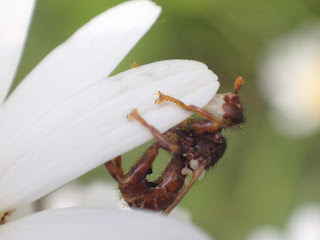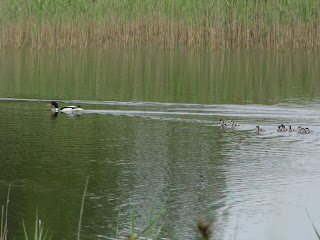2nd June 2018
On our way back after an out-of-county trip, Jeremy, Vanna, Ian and I stopped at Redgrave and Lopham Fen for lunch and a look for Fen Raft Spiders. This reserve on the county border is mostly in Norfolk but managed by the Suffolk Wildlife Trust. I'd never visited before but will have to return at some point, as it was a large site with loads of wildlife. We took the shortest trail (the spider trail) but still found lots to look at.
One of the standout species was the Four-spotted Chaser, a common dragonfly but one that was present in very large numbers. I noticed that several of them were of a variety called praenubila, where the small black marks are replaced by larger black splodges (compare the middle individual to the bottom one on the second photo). Unfortunately the 'best' one was obscurred by vegetation, but it looked very smart in the field.
Other things that caught our attention were some quivering Aspen trees, several species of beetle including Chrysolina polita, Dead-nettle Leaf Beetle and the large caterpillars of Drinker Moth, Garden Tiger and Emperor moth. A Hobby was seen briefly chasing the dragonflies, and a brood of Shelducks were on one of the pools.
Further round I noticed an Anasimyia contracta hoverfly, my third member of this genus seen this year (I've never seen the two remaining ones). One of my other highlights was a rare spider, Marpissa radiata - one of the NNNS 'Norfolk's Wonderful 150 Species' being profiled for next year's anniversary celebrations. As we headed back towards Norwich I noticed a Little Owl in a roadside tree, and after reversing back we managed to get silhouetted views (we didn't leave the car to see it properly to avoid spooking it).
A quick diversion to Mulbarton failed to yield the Bee Orchid that we had hoped for, but on dropping Jeremy and Vanna off we were shown some Asparagus Beetles, another new species for me.


















































